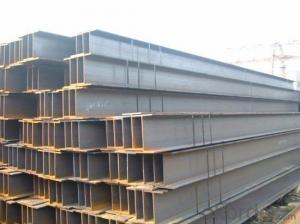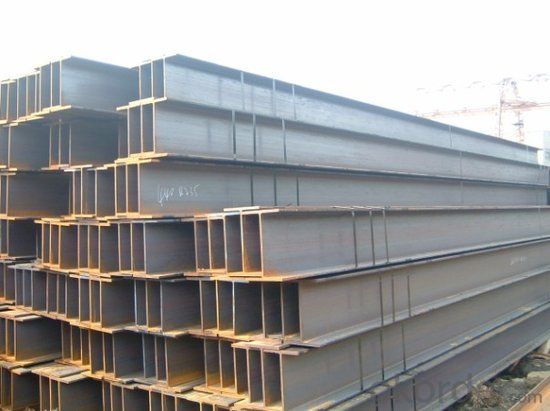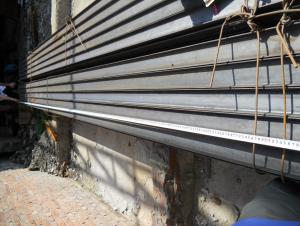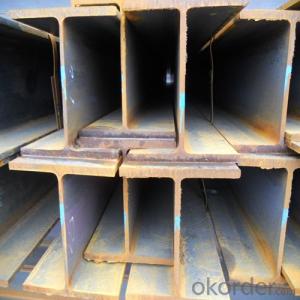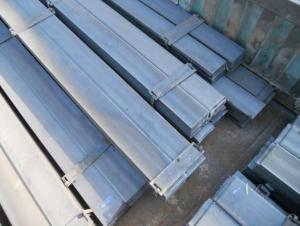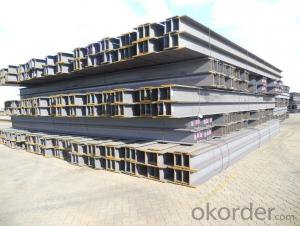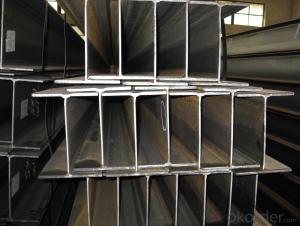Hot Rolled H Section Beam
- Loading Port:
- China Main Port
- Payment Terms:
- TT or LC
- Min Order Qty:
- 100 m.t.
- Supply Capability:
- 10000 m.t./month
OKorder Service Pledge
OKorder Financial Service
You Might Also Like
Product Description:
OKorder is offering Hot Rolled H Section Beam at great prices with worldwide shipping. Our supplier is a world-class manufacturer of steel, with our products utilized the world over. OKorder annually supplies products to African, South American and Asian markets. We provide quotations within 24 hours of receiving an inquiry and guarantee competitive prices.
Product Applications:
Hot Rolled H Section Beam are ideal for structural applications and are widely used inindustrial plants, civil construction, municipal works, oil platforms, bridges, flatbed beams, electrified railway power stand, railway bridges and other light steel structure, super-light H-beam is ideal for containers, mobile homes , all kinds of garage, box-type trains, electrical bracket, various venues, small villa manufacturing etc.
Product Advantages:
OKorder's Hot Rolled H Section Beam are durable, strong, and wide variety of sizes.
Main Product Features:
· Premium quality
· Prompt delivery & seaworthy packing (30 days after receiving deposit)
· Can be recycled and reused
· Mill test certification
· Professional Service
· Competitive pricing
Product Specifications:
Manufacture: Hot rolled
Grade: SS400, Q235,A36,S235JR
Standard: JIS G3101, GB STANDARD
Certificates: ISO, SGS, BV, CIQ
Length: 12m, as per customer request
Packaging: Export packing, nude packing, bundled
H Type Steel Size and Theoretical Weight | |||||
Size | Theoretical Weight | Size(mm) | Theoretical Weight | Size(mm) | Theoretical Weight |
(mm) | (kg/m) | (kg/m) | (kg/m) | ||
100*50*5*7 | 9.3 | 250*125*6*9 | 29 | 446*199*8*12 | 65.1 |
100*100*6*8 | 16.9 | 250*250*9*14 | 71.8 | 450*200*9*14 | 74.9 |
125*60*6*8 | 13.1 | 294*200*8*12 | 55.8 | 482*300*11*15 | 110.8 |
125*125*6.5*9 | 23.6 | 298*149*5.5*8 | 32 | 488*300*11*18 | 124.9 |
148*100*6*9 | 31.1 | 340*250*9*14 | 36.7 | 496*199*9*14 | 77.9 |
150*75*5*7 | 14 | 300*150*6.5*9 | 93 | 500*200*10*16 | 88.1 |
150*150*7*10 | 20.7 | 300*300*10*15 | 78.1 | 582*300*12*17 | 132.8 |
175*90*5*8 | 18 | 346*174*6*9 | 41.2 | 588*300*12*20 | 147 |
175*175*7.5*11 | 40.4 | 350*175*7*11 | 49.4 | 596*199*10*15 | 92.4 |
194*150*6*9 | 29.9 | 350*350*12*19 | 134.9 | 600*200*11*17 | 103.4 |
198*99*4.5*7 | 17.8 | 390*300*10*16 | 104.6 | 700*300*13*24 | 181.8 |
200*100*5.5*8 | 20.9 | 396*199*7*11 | 56.1 | 800*300*14*26 | 206.8 |
200*200*8*12 | 49.9 | 400*200*8*13 | 65.4 | 900*300*16*28 | 240.1 |
244*175*7*11 | 43.6 | 400*400*13*21 | 171.7 | ||
248*124*5*8 | 25.1 | 440*300*11*18 | 120.8 | ||
Length:12meters | |||||
FAQ:
Q1: How soon can we receive the product after purchase?
A1: Within three days of placing an order, we will arrange production. The normal sizes with the normal grade can be produced within one month. The specific shipping date is dependent upon international and government factors, the delivery to international main port about 45-60days.
Q2: How many tons of steel products could be loaded in containers?
A2: Usually the steel products are delivered by bulk vessel because of the large quantity and the freight. However, there are no bulk vessel enter some seaports so that we have to deliver the cargo by containers. The 6m steel product can be loaded in 20FT container, but the quantity is changed according to the size, usually from 18tons to 25tons.
Q3: How soon can we receive the product after purchase?
A3: Within three days of placing an order, we will arrange production. The normal sizes with the normal grade can be produced within one month. The specific shipping date is dependent upon international and government factors, the delivery to international main port about 45-60days.
Images:

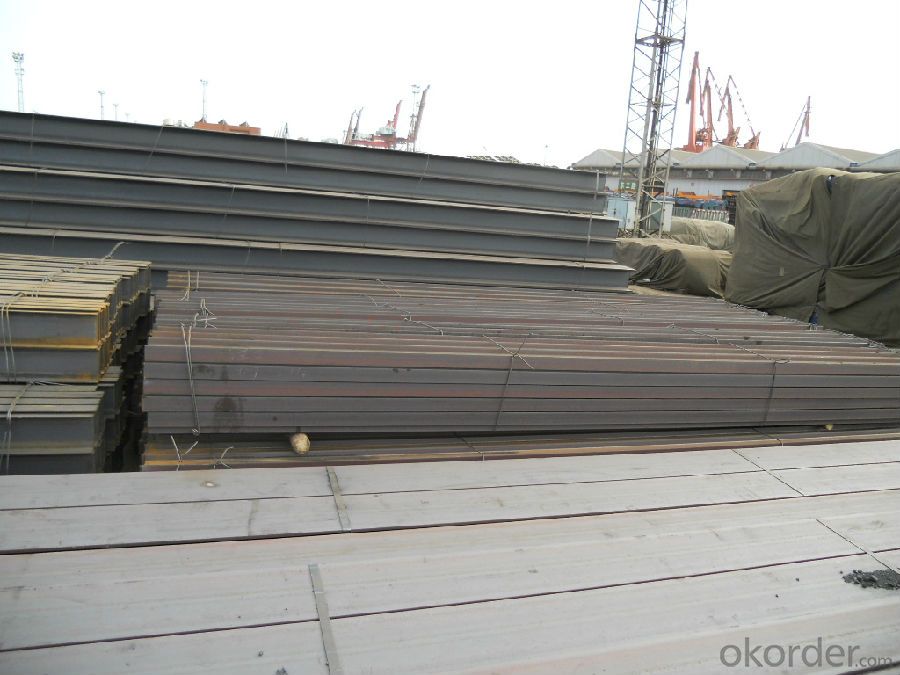
- Q:How do steel H-beams perform in oil and gas industry applications?
- Steel H-beams are highly durable and versatile, making them well-suited for various applications in the oil and gas industry. They offer excellent load-bearing capacity and structural stability, making them ideal for constructing platforms, support structures, and equipment frameworks. Additionally, steel H-beams possess high resistance to corrosion, which is crucial in the presence of oil and gas. Overall, steel H-beams are a reliable choice in the oil and gas industry due to their strength, durability, and ability to withstand harsh environments.
- Q:Are steel H-beams susceptible to corrosion?
- Yes, steel H-beams are susceptible to corrosion. However, their susceptibility to corrosion can be significantly reduced by applying protective coatings or using corrosion-resistant materials.
- Q:Can steel H-beams be used in seismic retrofitting?
- Seismic retrofitting, which reinforces existing structures to withstand seismic activity, can indeed utilize steel H-beams. These beams are frequently employed in seismic retrofitting due to their exceptional strength and flexibility. By employing steel H-beams in seismic retrofitting, seismic forces can be redistributed, effectively reducing the risk of structural damage during an earthquake. These beams are designed to absorb and dissipate the energy generated by seismic waves, preventing structural collapse. Moreover, steel H-beams can be easily installed and integrated into existing structures, making them a popular choice for seismic retrofitting projects. They can be bolted or welded to the existing framework, providing additional support and stability. Furthermore, engineers can choose from a variety of sizes and shapes of steel H-beams, enabling them to select the most appropriate beam for a specific retrofitting application. This versatility ensures that the retrofitting process can be customized to meet the unique requirements of each structure. In conclusion, steel H-beams are an ideal choice for seismic retrofitting due to their high strength, flexibility, easy installation, and wide range of options. They play a critical role in enhancing the seismic resilience of existing structures, ensuring their safety and durability in regions prone to seismic activity.
- Q:What are the different types of steel used for manufacturing H-beams?
- There are several types of steel commonly used for manufacturing H-beams, including mild steel, carbon steel, and high-strength low-alloy (HSLA) steel. The choice of steel depends on the specific requirements of the application, such as load-bearing capacity, structural strength, and cost-effectiveness.
- Q:How to process arc H steel?
- Small curvature component, is not the case, with the bending machine, about 600~800 yuan / ton, if the components or large curvature, according to the KONGGUOQING1, when considering the material, principle, or the use of thermal effect of heat bending, and bending frequency
- Q:How do steel H-beams contribute to the overall functionality of a building?
- By offering structural support and stability, steel H-beams play a vital role in the overall functionality of a building. These beams are specifically designed to endure heavy loads and evenly distribute weight across the building's framework. One noteworthy contribution of steel H-beams is their capacity to span long distances without requiring intermediate support columns. As a result, they allow for open and flexible floor plans, eliminating the need for excessive interior columns and maximizing usable space within the building. Moreover, steel H-beams possess exceptional load-bearing capabilities, making them ideal for supporting multi-story structures. They can withstand external forces like wind, earthquakes, and heavy snow loads, ensuring the building's stability and safety. In addition, steel H-beams contribute to the overall functionality of a building by facilitating efficient construction. Because of their standardized shape and size, these beams can be easily manufactured and transported to the construction site. Furthermore, their lightweight nature reduces the overall weight of the building, resulting in cost savings in foundation and construction materials. Furthermore, steel H-beams are highly durable and resistant to corrosion, making them a long-lasting structural component. This durability guarantees the longevity of the building and minimizes the need for frequent maintenance or repairs. In conclusion, steel H-beams make significant contributions to the overall functionality of a building by providing structural support, stability, and design flexibility. Their ability to withstand heavy loads, span long distances, and resist external forces enhances the safety, efficiency, and longevity of the structure.
- Q:What is the lifespan of steel H-beams?
- The lifespan of steel H-beams can vary depending on several factors such as the quality of the steel used, the conditions in which the beams are used, and the level of maintenance they receive. Generally, steel H-beams are designed to be durable and long-lasting, making them suitable for various structural applications. If properly manufactured and maintained, steel H-beams can have a lifespan of several decades or even longer. The high strength and structural integrity of steel allow it to withstand heavy loads, extreme weather conditions, and other external factors that can potentially degrade the material over time. However, it is important to note that various factors can contribute to the deterioration of steel H-beams. These factors include exposure to corrosive elements such as moisture, chemicals, and saltwater, as well as structural overload, excessive vibrations, and improper installation or handling. Regular inspections and maintenance are crucial to identify any signs of corrosion, fatigue, or structural damage that may affect the lifespan of the beams. In summary, the lifespan of steel H-beams can be extensive if they are well-manufactured, properly maintained, and used within their design limitations. By implementing appropriate maintenance practices and protecting the beams from adverse conditions, it is possible to extend their lifespan significantly.
- Q:How large H steel are used for steel roof with span of 19 meters and 26 meters respectively?
- The steel roof truss of 26 meters span adopts Q345 steel, the column section adopts H500 * 250 * 10 * 14, and the beam adopts H (800-500) * 220 * 12 * 14
- Q:How do steel H-beams perform in high-temperature environments such as industrial furnaces?
- Steel H-beams perform well in high-temperature environments such as industrial furnaces. This is primarily due to their excellent thermal conductivity and high melting point. The H-beams are typically made from structural steel, which is designed to withstand elevated temperatures without significant loss of strength or structural integrity. In high-temperature environments, steel H-beams are able to distribute heat evenly and quickly, minimizing the risk of localized overheating. This is crucial to prevent any deformation or failure of the beams, ensuring the overall stability and safety of the structure. Additionally, steel H-beams have a high melting point, typically around 1370°C (2500°F) for carbon steel. This allows them to withstand extreme heat without any substantial damage. Even in the hottest parts of an industrial furnace, where temperatures can exceed 1000°C (1832°F), steel H-beams remain structurally sound. Furthermore, steel H-beams have excellent fire resistance properties. They do not combust or contribute to the spread of fire, making them a reliable choice for high-temperature environments. This is particularly important in industrial furnaces, where fire hazards are a significant concern. Overall, steel H-beams are a suitable choice for high-temperature environments such as industrial furnaces. Their thermal conductivity, high melting point, and fire resistance properties make them capable of withstanding extreme heat without compromising on structural integrity or safety.
- Q:What are the common design considerations for steel H-beams in roofing applications?
- There are several common design considerations for steel H-beams in roofing applications. These considerations are important to ensure the structural integrity and safety of the roof. 1. Load-bearing capacity: Steel H-beams need to be designed to withstand the weight of the roof, as well as any additional loads such as snow, wind, or equipment. The beams should be properly sized and spaced to distribute the loads evenly and prevent any potential for failure or collapse. 2. Span and support spacing: The span and support spacing of the steel H-beams should be carefully determined based on the specific roof design and anticipated loads. The beams need to be adequately supported to prevent excessive deflection, sagging, or bending. The spacing between the beams should be determined in accordance with engineering standards and codes. 3. Connection details: The connections between the steel H-beams and other structural elements, such as columns or purlins, should be carefully designed and executed. The connections need to be strong and secure to ensure proper load transfer and to prevent any potential for disconnection or failure. 4. Fire resistance: Steel H-beams used in roofing applications should be designed to provide adequate fire resistance. This can be achieved through the use of fire-resistant coatings, insulation materials, or by incorporating fire-rated materials into the design. 5. Corrosion protection: Steel H-beams are susceptible to corrosion, especially in outdoor roofing applications where they are exposed to the elements. Proper corrosion protection measures, such as galvanizing or using corrosion-resistant coatings, should be implemented to extend the lifespan of the beams and maintain their structural integrity. 6. Thermal expansion and contraction: Steel H-beams need to be designed to accommodate thermal expansion and contraction due to temperature variations. This can be achieved by incorporating expansion joints or allowing for appropriate clearance and movement in the design. 7. Sustainability considerations: In modern design, sustainability is a key consideration. The use of recycled steel or incorporating energy-efficient design elements can contribute to the overall sustainability of the roofing system. Overall, the design of steel H-beams in roofing applications should take into account load-bearing capacity, span and support spacing, connection details, fire resistance, corrosion protection, thermal expansion and contraction, and sustainability considerations. By addressing these design considerations, the steel H-beams can provide a safe and durable roofing solution.
1. Manufacturer Overview |
|
|---|---|
| Location | |
| Year Established | |
| Annual Output Value | |
| Main Markets | |
| Company Certifications | |
2. Manufacturer Certificates |
|
|---|---|
| a) Certification Name | |
| Range | |
| Reference | |
| Validity Period | |
3. Manufacturer Capability |
|
|---|---|
| a)Trade Capacity | |
| Nearest Port | |
| Export Percentage | |
| No.of Employees in Trade Department | |
| Language Spoken: | |
| b)Factory Information | |
| Factory Size: | |
| No. of Production Lines | |
| Contract Manufacturing | |
| Product Price Range | |
Send your message to us
Hot Rolled H Section Beam
- Loading Port:
- China Main Port
- Payment Terms:
- TT or LC
- Min Order Qty:
- 100 m.t.
- Supply Capability:
- 10000 m.t./month
OKorder Service Pledge
OKorder Financial Service
Similar products
New products
Hot products
Hot Searches
Related keywords
